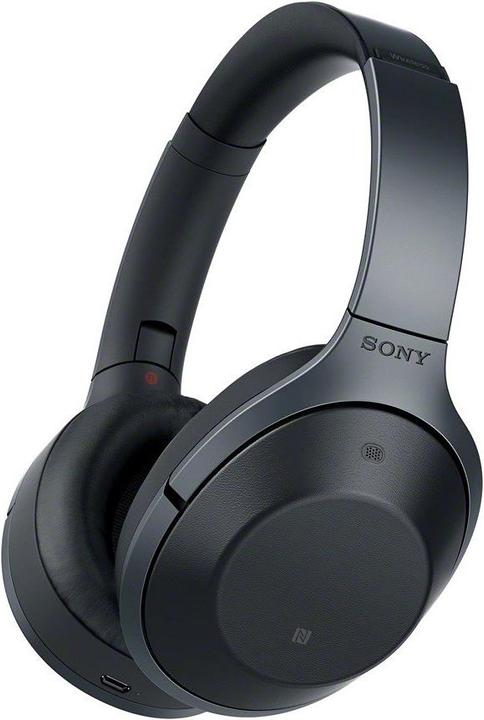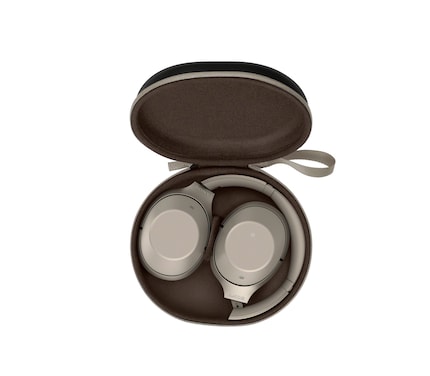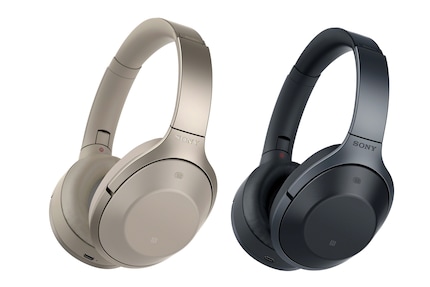

Sony MDR-1000X tested: The new reference for audiophiles with noise allergies?
The Sony MDR-1000X are high-quality over-ear headphones with a headset function that can be operated both with a cable and via Sony's own LDAC Bluetooth. On top of that, they also feature noise cancelling. Has Sony hit the jackpot?
The MDR-1000X not only looks good when new, but also looks good to the touch. This is despite the fact that, apart from the highly flexible steel bracket, the majority of the headphones are made of plastic. The apparently used beige-coloured specimen that avguide.ch received for testing already had the elegant metal colour chipped off the plastic in two places and a dark plastic that looked cheap emerged. In order to preserve its beauty over a longer period of time, the handset should be handled with care and stored in the case supplied.
The pleasant-to-touch ear pads, which according to Sony are made of real leather on one side and soft plastic on the other, appear to be somewhat narrow. But this is deceptive, as they are partially hidden behind a sound insulation ring. Anyone who puts the headphones on will be amazed at how stable and comfortable these 275 gram headphones sit on the head over time.

The MDR-1000X has three operating modes:
- 1: Passive via cable, for example when the battery is empty
- 2: Active via cable, where the sound is electronically linearised
- 3: Without cable via Bluetooth
Of course, the mobile handset is equipped with a hands-free system and plays for around 20 hours after being charged for at least 4 hours in the worst-case scenario, i.e. with Bluetooth and noise cancelling.
Sophisticated, simple and yet convenient
The operation of the headphones is sophisticated and convenient. The three push buttons on the left ear cup, which are a little difficult to feel at first, have the following functions:
- 1: On-Off - Pairing
- 2: Noise Cancelling On-Off / NC - Optimiser,
- 3: Ambient sound in two levels
Audiophile listeners should be aware that when the headphones are switched to active, the unfortunately somewhat sound-reducing noise cancelling is automatically switched on. If you want to listen to really audiophile music in a quiet environment, it is best to switch off the NC.
The right ear cup is touch-sensitive. Tap twice and the music starts, stops or you can take calls. Swiping your finger from bottom to top increases the volume, swiping from top to bottom decreases it. You can advance or rewind a track by swiping forwards or backwards.
Noise cancelling is always fully effective, regardless of whether there is noise or not. Remember the Sennheiser PXC 550, whose noise cancelling only intervenes when noise is present. Particularly sensitive listeners sometimes complain about a certain amount of pressure on the eardrum when the noise cancelling is switched on. This may well be the case with the MDR-1000X, but not with the PXC 550, so it's best for everyone to try it out for themselves to see if it bothers them. I'm obviously one of those "non-sensitive" people who don't feel a certain unpleasant pressure on the eardrum. However, this can also be described as "deformation professional" in my case....

If you want to switch off the noise cancelling for a moment, simply place your hand on the right ear cup and you can hear what's going on out there. If you press the NC button for two seconds, an optimiser is started that optimally adjusts the NC to the ear canal and the noise from the outside world in order to achieve the best possible noise cancellation.
To be able to hear something of the surroundings while listening to music, the two modes "Ambient Normal" and "Ambient Voice" are available. These closed headphones then behave in a similar way to headphones with a semi-open or fully open design, which still allow ambient noise to be heard, which can be particularly useful for announcements in railway stations or when monitoring small children. The "Ambient Normal" setting allows practically all ambient noise to reach the ear canal, while the "Ambient Voice" setting only allows frequencies above 200 Hz to pass through.
High-end Bluetooth
Although the MDR-1000X also supports Bluetooth with aptX, it has also been equipped with the company's own LDAC system, which is said to achieve a transmission rate of up to 990 kbit/s. This is very close to a high-end Bluetooth system. This is already very close to CD quality, but not yet true HighResolution.
The internal DSEE HX sound enhancement is also supposed to add back the sound components that were removed during data reduction (MP3, AAC etc.) and bring the sound up to a high-resolution level. But this is a bold claim that not only I strongly doubt.

Attention scratches. The metal-coloured plastic parts of the beige version must be handled with care.
Who measures, does not always measure crap
In the audio lab at avguide.ch, the DRM-100X was measured together with headphones such as the Bose QC 35 and the Sennheiser PXC 550. The frequency response, effect of the ambient modes and the effect of noise cancelling were measured.
The frequency response of the MDR-1000X in passive mode, i.e. when the battery is empty, is very unbalanced and shows a drastic dip at 2 kHz in addition to a boost at 100 Hz. The listening test shows how this sounds. The frequency response is completely different in active mode. Here, the frequency response is linearised to such an extent that the aforementioned boost and dip are no longer noticeable at all.
It is pleasing to note that the frequency responses on the cable and via Bluetooth hardly differ. However, this says little about the subtle sound differences in the HiRes range. The measurement of the "Ambient Sound" shows that in the "Normal" setting, the full spectrum of the ambient sound is sent to the listener apart from a mid-range cut. In the "Voice" setting, however, the lower frequencies below 200 Hz are held back. This means that voices in particular are audible, but not low-frequency engine noise. The noise cancelling measurement results clearly place the headphones in the top class. There was a neck-and-neck race here between the Bose QC35 and the MDR-1000X that neither could win. Depending on the frequency position, one or the other headphone was better at attenuating ambient noise.

The Sony MDR-1000X is available in beige or black
Passive moderate - active very good
The MDR-1000X can continue to play even when the battery is empty. However, the sound is then puffy and weak. As our measurements in the avguide.ch audio lab showed, the frequency response here is not very balanced and the sound is correspondingly poor. In active mode, without noise cancelling switched on, the listener sounds transformed - balanced, spacious and brilliant without being annoying due to any bloated pitches. The bass extends right down to the lowest frequencies without blowing them up into a booming bass, as certain trendy listeners do. No, there are no cheap sonic tricks here, a clean hi-fi sound prevails.
This makes listening to a violin concerto, a big band or even hard rock a pleasure. Thanks to its balance, the listener is a real jack-of-all-trades that performs with relish in all styles of music.
Efficient noise killer
When noise cancelling is activated, the sound hardly deteriorates noticeably. With classical music, the sound definition of the fine harpsichord plucks is reduced and the timbre of the strings loses timbre. The same applies to cymbal crashes and other percussive instruments, which lose a little of their brilliance and vitality. However, the great gain in clarity of the sound image in a noisy environment is disproportionate to the very slight deterioration in sound quality.
The comparison of the previous noise-cancelling class leader, the Bose QC 35, and the MDR-1000X shows what the measurements already indicated: depending on the type of noise, sometimes one and sometimes the other headphone is ahead in terms of noise cancellation. Both headphones demonstrate what is possible today in terms of noise cancellation.

KO punch for iPhone
A highly explosive comparison now consists of listening to the CD ripped in WAV format with Vivaldi's violin concertos with Andrew Manze and the ensemble "The English Concert" once from the iPhone and once via the Sony NW-A35 HiRes player via Bluetooth. The iPhone, which doesn't support aptX, doesn't make the strings sound ugly, but it does suppress quite a lot of tonal detail and is reminiscent of data-reduced MP3 or AAC playback. The audiophile music enjoyment is therefore very limited.
The NW-A35 with its LDAC Bluetooth system is a completely different story. Here you can clearly hear the whole marvellous atmosphere of these baroque string works, from the lowest double bass to the cellos and violas to the highest violin. The sound quality is roughly the same as the original CD! The same results are achieved with sophisticated jazz, folk and pop. The combination of the NW-A35 and the MDR-1000X can be described as an ideal team and puts playback from many smartphones in the deepest shadow.
The limits of LDAC
Now, however, comes the toughest test for the LDAC: comparing a HiRes recording, once via cable and the other time via Bluetooth with LDAC. The result is quickly described. With MacLeod's blues recording "There's a time" (Reference Recording in Hires), the fantastic live atmosphere is significantly diminished. In addition, MacLeod's rough voice clearly loses character. With Bach violin works, the full beauty of Joshua Bell's Stradivarius only comes into its own via cable. The sound is clearly less well defined via Bluetooth, lacking the magical, mysterious aura of Bell's Stradivarius.
But hand on heart: even if you prefer to listen to HiRes recordings via cable, you can also enjoy them via Bluetooth with LDAC...
Conclusion
The Sony MDR-1000X is without a doubt one of the absolute best circumaural headphones with noise cancelling and an exceptionally good sounding LDAC Bluetooth. However, it's not exactly a bargain and the beige-coloured design with its metal-coloured plastic parts requires careful handling.
You might also be interested in this
As dipl. musician, EL. Ing. HTL and founding member of the internet platform <a href="http://www.avguide.ch/" target="_blank">www.avguide.ch</a>, I am interested in electronics, especially when it makes music of the highest quality. So testing - i.e. listening to, measuring and describing loudspeakers, amplifiers, headphones, high-resolution audio players etc. - is my passion. Besides that, as an active bass player, for me it's true: No bass, no fun!
Interesting facts about products, behind-the-scenes looks at manufacturers and deep-dives on interesting people.
Show all